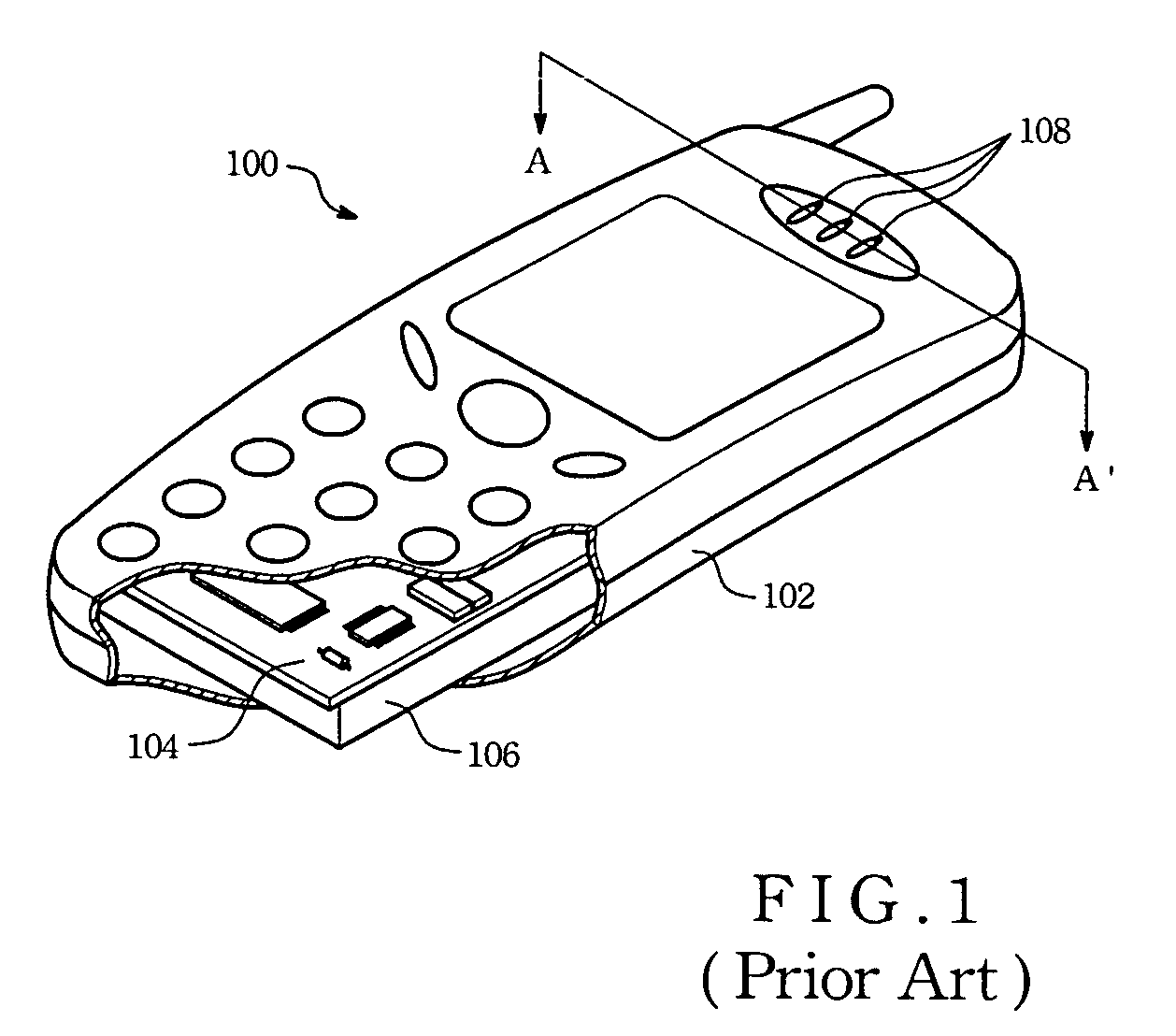Resonance chamber of a cellular phone
a cellular phone and resonance chamber technology, applied in the direction of electrical transducers, final product manufacture, printed circuit non-printed electric components association, etc., can solve the problems of sacrificing the portability of the cellular phone, the resonance effect of the low frequency voice would be worse, and the cellular phone is larger. to achieve the effect of improving the resonance effect of the low frequency voi
- Summary
- Abstract
- Description
- Claims
- Application Information
AI Technical Summary
Benefits of technology
Problems solved by technology
Method used
Image
Examples
first embodiment
[0033]FIG. 4 is a cross-section view of the cellular phone 200 in accordance with the present invention. A shell 202 of the cellular phone 200 encloses an inner space and has at least a first opening 208 (three shown in the figure) with a size ranged from 1 mm2 to 100 mm2 is formed on a front portion of the shell 202 to communicate the inner space 220 to the environment. A circuit board 204 is disposed within the inner space and further divides the inner space into a first acoustic room 220 and a second acoustic room 240. A voice generator 210, for example a speaker, is disposed within the first acoustic room 220 and further divides the first acoustic room 220 into a front space 222 and a rear space 224. The voice generator 210 also electrically connects to the circuit board 204 to access controlling signals and a power supply. In addition, a through hole 207, which is aligned to a center of the voice generator 210, is formed in the circuit board 204 to communicate the first acousti...
second embodiment
[0037]FIG. 6 shows the cellular phone 200 in accordance with the present invention. By contrast to the cellular phone 100 of FIG. 2, the cellular phone 200 in the present embodiment has a second opening 203 formed on the shell 202 to communicate the rear space 224 to the environment for purposely flattening the resonance curve to prevent from the shrill voice.
[0038]FIG. 7 shows frequency resonance curves calculated according to the simulation results of the cellular phone 100 of FIG. 2 (denoted as example 1) and the cellular phone 200 of FIG. 6 (denoted as example 3). The solid-lined resonance curve of the cellular phone 100 of FIG. 2 is calculated by given a 40 mm2 first opening 108, a 19 mm-diameter speaker 110, a 1.15 ml front space 122, a 2.04 ml rear space 124, a 1 mm thick circuit board 104, and a 1 mm thick shell 102. The center-lined resonance curve of the cellular phone 200 of FIG. 6 is calculated by given a 40 mm2 first opening 208, a 19 mm-diameter speaker 210, a 1.15 ml ...
third embodiment
[0040]FIG. 8 shows the cellular phone in accordance with the present invention. By contrast to the cellular phone of FIG. 4, the cellular phone in the present embodiment has a second opening 203 on the shell 202 to communicate the second acoustic room 224 to the environment in addition to a through hole 207 for communicating the first acoustic room 222 and the second acoustic room 224.
[0041]In is also noted that in the three embodiments mentioned above, there has only one second opening 203 or one through hole 207 formed in the cellular phone 200. However, the number of the through hole 207 may increase to fifteen with a total opening size ranged from 1 mm2 to 500 mm2 according to the need, and the number of the second opening 203 may increase to five with a total opening size ranged from 1 mm2 to 500 mm2 according to the need. In addition, the size of the cellular phone must be constrained to an acceptable and portable size. Therefore, the size of the first acoustic room 220 is ran...
PUM
 Login to View More
Login to View More Abstract
Description
Claims
Application Information
 Login to View More
Login to View More - R&D
- Intellectual Property
- Life Sciences
- Materials
- Tech Scout
- Unparalleled Data Quality
- Higher Quality Content
- 60% Fewer Hallucinations
Browse by: Latest US Patents, China's latest patents, Technical Efficacy Thesaurus, Application Domain, Technology Topic, Popular Technical Reports.
© 2025 PatSnap. All rights reserved.Legal|Privacy policy|Modern Slavery Act Transparency Statement|Sitemap|About US| Contact US: help@patsnap.com



